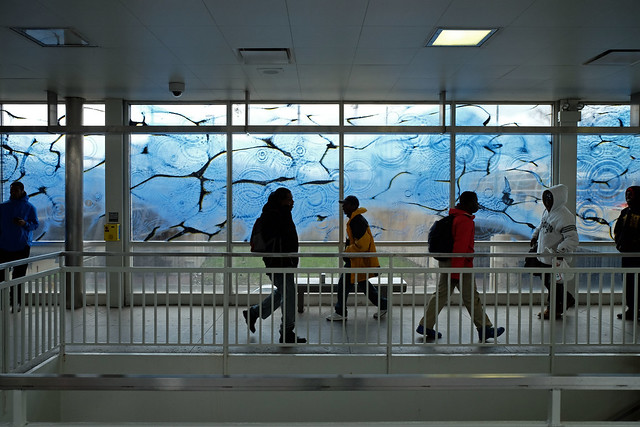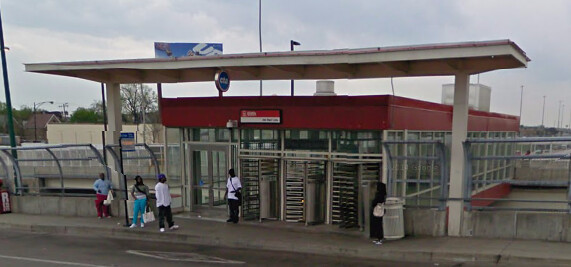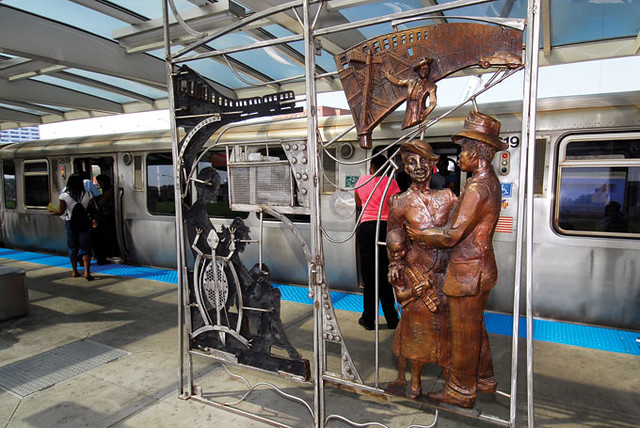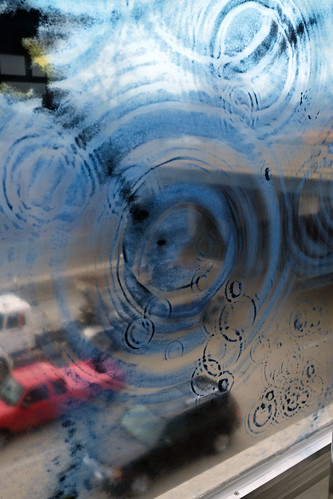Local artist Doug Fogelson wants his new, water-inspired installation at the Red Line’s 69th station to have a ripple effect, improving the daily commute for thousands of Chicagoans. “My goal was to to create something timeless, elemental, and slightly abstract, that would enhance the experiences of people moving through the station or working there, over a long time span,” he said.
The work, entitled “Sanctuary,” consists of a permanent photo collage featuring images of ripples and waves, printed on six glass window panels on the west side of the station. It’s the third and latest art installation as part of the $425 million CTA’s Red Line South reconstruction project, which replaced 10.2 miles of track last year and rehabbed all eight ‘L’ stops between 87th Street and Cermak. The 95th Streets station is currently undergoing a massive, $240 million overhaul.
The eight train stops were upgraded with new lights, paint, electrical substation work, and other improvements. As part of the makeovers, each station is also getting new public art. All except the Cermak-Chinatown stop had existing artwork that will remain in place. The price tag for the eight new pieces, including artist fees, fabrication, shipping and other expenses, but excluding installation, is $590,400, bankrolled by transit enhancement funds from the Federal Transportation Administration.
The CTA held a call for artists in June 2013, but re-advertised the bid that November, “acting in our best interest,” according to spokeswoman Catherin Hosinski. Altogether, the CTA received more than 300 submissions, which were evaluated by a committee on the basis of artistic merit, qualifications, and professional recognition of the artists, Hosinski said.
A piece by Andrew Hall was installed in mid-February at the 47th Street station, followed by a work by McArthur Binion at the 79th Street stop in late March. Fogelson’s installation went in last week. The remaining five pieces should be installed this year.
Prior to this commission, Fogelson (an old acquaintance of mine) had an "always a bridesmaid, never a bride” relationship to the CTA. About ten years ago, he was short-listed to create art for a Blue Line station in Lawndale, and eight years ago he was a finalist to provide an installation for another ‘L’ stop. “The third time was the charm,” he said. He declined to say how much he was paid for the work, but noted that the artist’s fee can only make up ten percent of the total cost of a CTA art piece.
With its amorphous, watery imagery, “Sanctuary” contrasts with and complements the existing, representational piece at the 69th Street stop, “A Need to Remember,” created by Preston Jackson in 2007. That piece, consisting of a two-sided bronze and stainless screen at track level, features images from African-American history and culture, including Chicago street life, a hair-braiding scene, and an African tortoise symbol.
“I did not want to make something that was didactic or typical of public art, not that I’m turning up my nose at typical public art,” Fogelson said. “The imagery in my installation is water, drops, ripples, and light reflecting through the water. It’s connected to the fresh water resources that we have here, the lake and the river. In good times and bad times, we can go to the lakefront as a place of refuge and of sanctuary.”
The drops and ripple imagery is also a metaphor for individuals and the effects they can have on their neighborhoods and the larger community, Fogelson said. “It shows the ever-expanding spheres of influence they can have, and also the interaction between those spheres. Just as many drops make up a river or a lake, many people make up a community.”
More concretely, Fogelson hoped to visually soften the station space. “It’s in a very intense location, between two bridges in the middle of a very busy [Dan Ryan] expressway,” he said. “You’ve got turnstiles, pay boxes, and other machinery there, so the only available space was the west wall. I was trying to create an organic counterpart to all of the grid and the metal that’s happening there. ‘Sanctuary’ also refers to this being kind of a foil to the crazy chaos of that kind of space.”
The public input process for the artwork included review sessions where Fogelson displayed renderings of the installation and answered questions from residents from the surrounding Grand Crossing and Hamilton Park communities. “People told me about how the imagery made them feel, and the feedback was very positive, which made me really happy,” he said.
The photo collage is made up of many different individual shots of drops and ripples taken at Fogelson’s studio, as well as pictures of water taken at outdoor swimming pools. “I digitally combined the images, and then they were printed by a glass fabricator,” he said. “Instead of ink, the pigment is actually glass powder, and then it gets fired in a kiln.” Next, the image was airbrushed with more glass powder, and then fired again. Finally, each panels was laminated with a second pane of glass, so that the images reside within a “glass sandwich.”
Fogelson says he appreciates how the appearance of the mural changes according to the time of day, and whether the light source is sunlight or street lamps and indoor lighting. In the late afternoon, when the sun rays are lower, the light shines right into the station house, so that the watery blue images are projected on the station floor and the people passing by, and the mural also becomes more transparent.
“I hope that the artwork will build up a relationship with the riders over time, and that they will grow increasingly fond of it,” Fogelson said.









